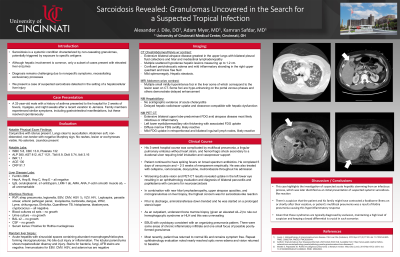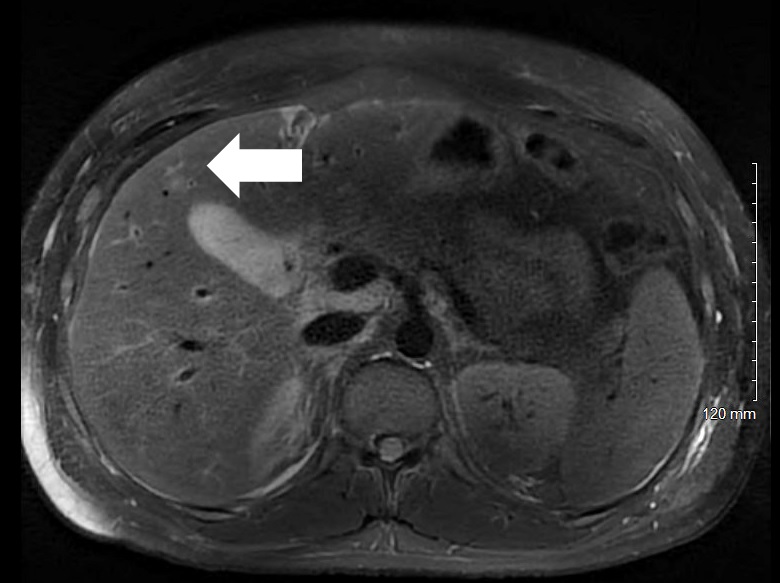Monday Poster Session
Category: Liver
P3068 - Sarcoidosis Revealed: Granulomas Uncovered in the Search for a Suspected Tropical Infection
Monday, October 28, 2024
10:30 AM - 4:00 PM ET
Location: Exhibit Hall E

Has Audio

Alexander J. Dile, DO
University of Cincinnati Medical Center
Cincinnati, OH
Presenting Author(s)
Alexander J. Dile, DO, Adam Myer, MD, Kamran Safdar, MD
University of Cincinnati Medical Center, Cincinnati, OH
Introduction: Sarcoidosis is a systemic condition characterized by non-caseating granulomas, potentially triggered by exposure to specific antigens. Although hepatic involvement is common, only a subset of cases present with elevated liver enzymes. Diagnosis remains challenging due to nonspecific symptoms, necessitating exclusionary processes. Here we present a case of sarcoidosis detected in the setting of a suspected infectious exposure.
Case Description/Methods: A 33-year-old male with history of asthma presented to the hospital for 2 weeks of fevers, myalgias, and night sweats after a recent vacation to Jamaica. Family members experienced similar symptoms, including gastrointestinal manifestations, but these resolved spontaneously. His liver tests peaked at ALP 380, AST 812, ALT 1121, Tbili 8.9, Dbili 5.74, Ibili 3.16. CT and MRCP showed multiple small scattered hypodense hepatic lesions and non-specific gallbladder changes (Figure 1). Random liver biopsy showed acute hepatitis with focal hepatic parenchymal necrosis and microgranulomas, favoring infection. Other chronic liver labs were negative. Patient continued to have spiking fevers on broad spectrum antibiotics, and a broad infectious workup including local and tropical bacterial, fungal, and parasitic pathogens of the serum, CSF, and BAL were all negative except for Rothia mucilaginosa on serum Karius. His hospital course was complicated by hemorrhagic shock secondary to a duodenal ulcer, a pulmonary embolus, and multifocal pneumonia. Worsening double vision and a PET-CT revealed uptake in the left eye resulting in an ophthalmology evaluation and diagnosis of bilateral panuveitis. In combination with an elevated ACE level, new hilar lymphadenopathy and microgranulomas on liver biopsy, the highest concern was for sarcoidosis. Aminotransferase down trended to ALP 196, ALT 181, AST 61, TBili 1.2, Dbili 0.41, Ibili 0.79 and he was discharged on a steroid taper with plan for outpatient confirmatory testing.
Discussion: This case highlights the investigation of a suspected case of acute hepatitis stemming from an infectious process, which was later identified as an initial presentation of sarcoidosis. There is suspicion that the patient and his family might have contracted a foodborne illness on their vacation, or that his possible Rothia pnuemonia resulted in this hyperinflammatory response. Given that sarcoidosis is typically diagnosed by exclusion, maintaining a high level of suspicion and keeping a broad differential is crucial in such scenarios.

Disclosures:
Alexander J. Dile, DO, Adam Myer, MD, Kamran Safdar, MD. P3068 - Sarcoidosis Revealed: Granulomas Uncovered in the Search for a Suspected Tropical Infection, ACG 2024 Annual Scientific Meeting Abstracts. Philadelphia, PA: American College of Gastroenterology.
University of Cincinnati Medical Center, Cincinnati, OH
Introduction: Sarcoidosis is a systemic condition characterized by non-caseating granulomas, potentially triggered by exposure to specific antigens. Although hepatic involvement is common, only a subset of cases present with elevated liver enzymes. Diagnosis remains challenging due to nonspecific symptoms, necessitating exclusionary processes. Here we present a case of sarcoidosis detected in the setting of a suspected infectious exposure.
Case Description/Methods: A 33-year-old male with history of asthma presented to the hospital for 2 weeks of fevers, myalgias, and night sweats after a recent vacation to Jamaica. Family members experienced similar symptoms, including gastrointestinal manifestations, but these resolved spontaneously. His liver tests peaked at ALP 380, AST 812, ALT 1121, Tbili 8.9, Dbili 5.74, Ibili 3.16. CT and MRCP showed multiple small scattered hypodense hepatic lesions and non-specific gallbladder changes (Figure 1). Random liver biopsy showed acute hepatitis with focal hepatic parenchymal necrosis and microgranulomas, favoring infection. Other chronic liver labs were negative. Patient continued to have spiking fevers on broad spectrum antibiotics, and a broad infectious workup including local and tropical bacterial, fungal, and parasitic pathogens of the serum, CSF, and BAL were all negative except for Rothia mucilaginosa on serum Karius. His hospital course was complicated by hemorrhagic shock secondary to a duodenal ulcer, a pulmonary embolus, and multifocal pneumonia. Worsening double vision and a PET-CT revealed uptake in the left eye resulting in an ophthalmology evaluation and diagnosis of bilateral panuveitis. In combination with an elevated ACE level, new hilar lymphadenopathy and microgranulomas on liver biopsy, the highest concern was for sarcoidosis. Aminotransferase down trended to ALP 196, ALT 181, AST 61, TBili 1.2, Dbili 0.41, Ibili 0.79 and he was discharged on a steroid taper with plan for outpatient confirmatory testing.
Discussion: This case highlights the investigation of a suspected case of acute hepatitis stemming from an infectious process, which was later identified as an initial presentation of sarcoidosis. There is suspicion that the patient and his family might have contracted a foodborne illness on their vacation, or that his possible Rothia pnuemonia resulted in this hyperinflammatory response. Given that sarcoidosis is typically diagnosed by exclusion, maintaining a high level of suspicion and keeping a broad differential is crucial in such scenarios.

Figure: Fat-suppressed T2 weighted axial cross section of MRCP highlighting one of the scattered small mildly hyperintense foci measuring 8 mm
Disclosures:
Alexander Dile indicated no relevant financial relationships.
Adam Myer indicated no relevant financial relationships.
Kamran Safdar indicated no relevant financial relationships.
Alexander J. Dile, DO, Adam Myer, MD, Kamran Safdar, MD. P3068 - Sarcoidosis Revealed: Granulomas Uncovered in the Search for a Suspected Tropical Infection, ACG 2024 Annual Scientific Meeting Abstracts. Philadelphia, PA: American College of Gastroenterology.
